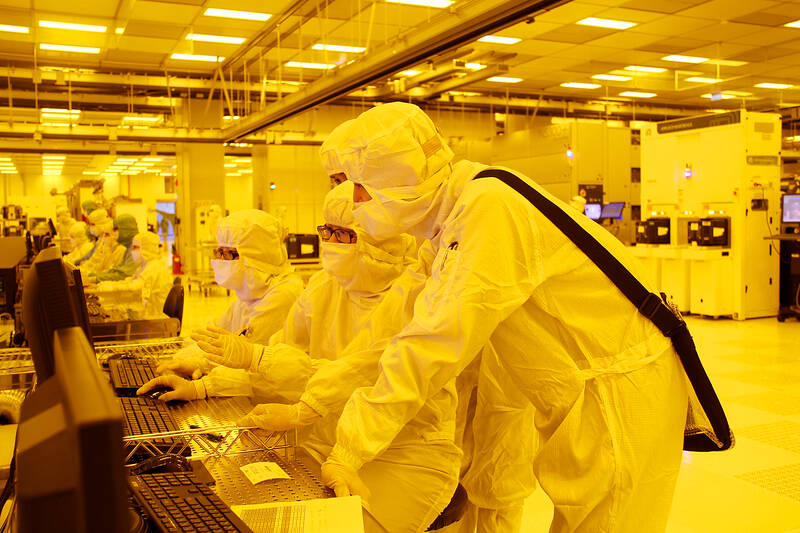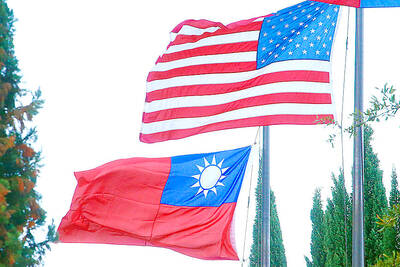The Ministry of Economic Affairs yesterday set the research-and-development (R&D) investment threshold at NT$6 billion (US$195.2 million) for companies to qualify for tax incentives under recently approved amendments to the Act for Industrial Innovation (產業創新條例), or Taiwan’s version of the US’ CHIPS and Science Act.
That requirement is less strict than the government’s original plan of setting a threshold of between NT$5 billion and NT$10 billion. However, it is much higher than the annual average of NT$3 billion spent on R&D by the nation’s top 100 companies, Industrial Development Bureau data showed.
Companies are also required to set aside at least 6 percent of their revenue for R&D to qualify for the incentives, the ministry said.

Photo courtesy of Siliconware Precision Industries Co
Top businesses that are strategically important to global supply chains are the target of the new tax break program, rather than small and medium-sized companies, which are eligible for similar tax breaks on smart manufacturing under other rules, the bureau said.
Besides, the program is aimed at encouraging more overseas Taiwanese businesses to invest back home, it said.
Semiconductor firms are not the only companies eligible for the tax breaks, the ministry said. The program is also applicable to companies that are capable of developing world-leading or innovative and scalable technology in strategic industries such as 5G, electric vehicles and low Earth orbit satellites.
The Legislative Yuan passed the amendments to the Act for Industrial Innovation in January, boosting tax breaks for local companies’ R&D investment from 15 percent to 25 percent, and offering an additional 5 percent tax credit for NT$10 billion spent on new equipment for advanced process technology, in parallel with the US’ Creating Helpful Incentives to Produce Semiconductors (CHIPS) and Science Act to boost advanced chip capacity.
As for the minimum corporate income tax rate, it would remain at 12 percent this year for qualified businesses and rise to 15 percent in 2025, the ministry said.
The ministry said it prefers to maintain some flexibility regarding the minimum rate for next year, which would likely hinge on the tax rates imposed by Organisation for Economic Co-operation and Development members.
The new tax incentives will be in place for seven years, starting this year, and the ministry will start accepting applications next year based on their investments this year.
Taiwan Semiconductor Manufacturing Co (TSMC, 台積電) is widely considered to be on top of the short list for tax breaks, as the world’s biggest contract chipmaker plans has set capital expenditure this year at US$32 billion to US$36 billion.
TSMC allocates about 8 percent of its annual revenue to R&D expenditure, with 80 percent of the amount going into next-generation technology, the company’s annual report says.
TSMC has said that its 2-nanometer process technology would be the world’s most advanced technology when it becomes commercially available in 2025.

UPDATED (3:40pm): A suspected gas explosion at a shopping mall in Taichung this morning has killed four people and injured 20 others, as emergency responders continue to investigate. The explosion occurred on the 12th floor of the Shin Kong Mitsukoshi in Situn District (西屯) at 11:33am. One person was declared dead at the scene, while three people were declared deceased later after receiving emergency treatment. Another 20 people sustained major or minor injuries. The Taichung Fire Bureau said it received a report of the explosion at 11:33am and sent rescuers to respond. The cause of the explosion is still under investigation, it said. The National Fire

ACCOUNTABILITY: The incident, which occured at a Shin Kong Mitsukoshi Department Store in Taichung, was allegedly caused by a gas explosion on the 12th floor Shin Kong Group (新光集團) president Richard Wu (吳昕陽) yesterday said the company would take responsibility for an apparent gas explosion that resulted in four deaths and 26 injuries at Shin Kong Mitsukoshi Zhonggang Store in Taichung yesterday. The Taichung Fire Bureau at 11:33am yesterday received a report saying that people were injured after an explosion at the department store on Section 3 of Taiwan Boulevard in Taichung’s Situn District (西屯). It sent 56 ambulances and 136 paramedics to the site, with the people injured sent to Cheng Ching Hospital’s Chung Kang Branch, Wuri Lin Shin Hospital, Taichung Veterans General Hospital or Chung

‘TAIWAN-FRIENDLY’: The last time the Web site fact sheet removed the lines on the US not supporting Taiwanese independence was during the Biden administration in 2022 The US Department of State has removed a statement on its Web site that it does not support Taiwanese independence, among changes that the Taiwanese government praised yesterday as supporting Taiwan. The Taiwan-US relations fact sheet, produced by the department’s Bureau of East Asian and Pacific Affairs, previously stated that the US opposes “any unilateral changes to the status quo from either side; we do not support Taiwan independence; and we expect cross-strait differences to be resolved by peaceful means.” In the updated version published on Thursday, the line stating that the US does not support Taiwanese independence had been removed. The updated

‘LAWFUL USE’: The last time a US warship transited the Taiwan Strait was on Oct. 20 last year, and this week’s transit is the first of US President Donald Trump’s second term Two US military vessels transited the Taiwan Strait from Sunday through early yesterday, the Ministry of National Defense said in a statement, the first such mission since US President Donald Trump took office last month. The two vessels sailed south through the Strait, the ministry said, adding that it closely monitored nearby airspace and waters at the time and observed nothing unusual. The ministry did not name the two vessels, but the US Navy identified them as the Arleigh Burke-class guided-missile destroyer USS Ralph Johnson and the Pathfinder-class survey ship USNS Bowditch. The ships carried out a north-to-south transit from